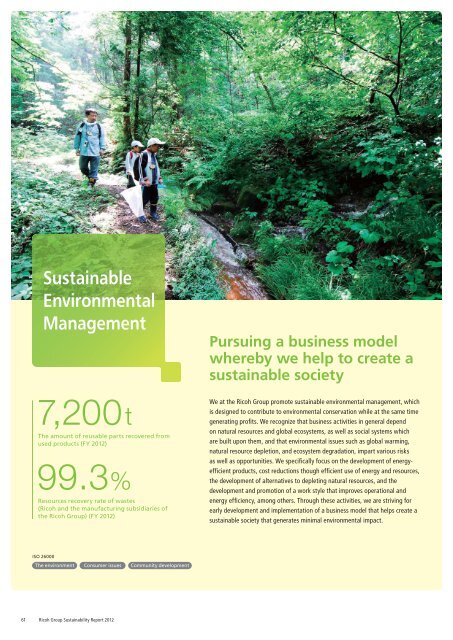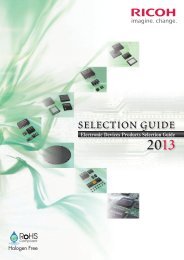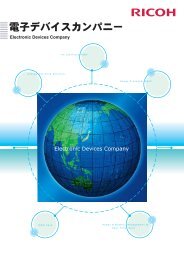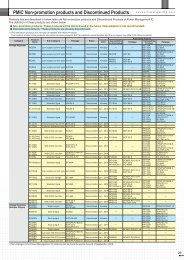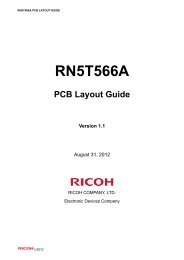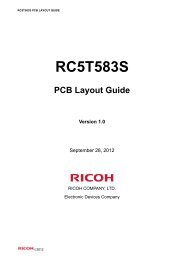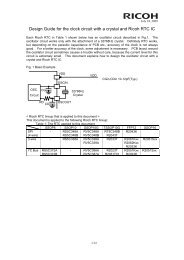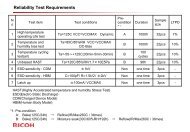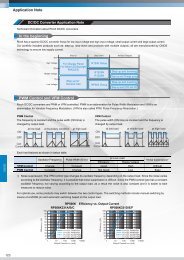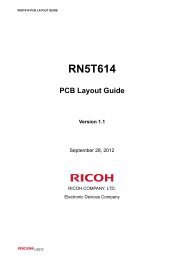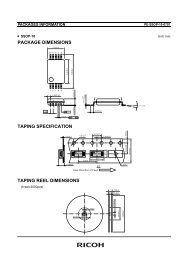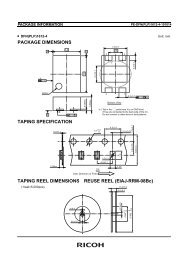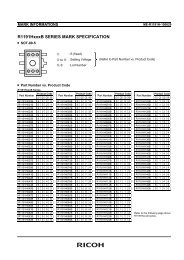Sustainable Environmental Management - Ricoh
Sustainable Environmental Management - Ricoh
Sustainable Environmental Management - Ricoh
Create successful ePaper yourself
Turn your PDF publications into a flip-book with our unique Google optimized e-Paper software.
<strong>Sustainable</strong> <strong>Environmental</strong> <strong>Management</strong><br />
<br />
<br />
<br />
7,200 t<br />
The amount of reusable parts recovered from<br />
used products (FY 2012)<br />
99.3%<br />
Resources recovery rate of wastes<br />
(<strong>Ricoh</strong> and the manufacturing subsidiaries of<br />
the <strong>Ricoh</strong> Group) (FY 2012)<br />
Pursuing a business model<br />
whereby we help to create a<br />
sustainable society<br />
We at the <strong>Ricoh</strong> Group promote sustainable environmental management, which<br />
is designed to contribute to environmental conservation while at the same time<br />
generating profits. We recognize that business activities in general depend<br />
on natural resources and global ecosystems, as well as social systems which<br />
are built upon them, and that environmental issues such as global warming,<br />
natural resource depletion, and ecosystem degradation, impart various risks<br />
as well as opportunities. We specifically focus on the development of energyefficient<br />
products, cost reductions though efficient use of energy and resources,<br />
the development of alternatives to depleting natural resources, and the<br />
development and promotion of a work style that improves operational and<br />
energy efficiency, among others. Through these activities, we are striving for<br />
early development and implementation of a business model that helps create a<br />
sustainable society that generates minimal environmental impact.<br />
ISO 26000<br />
The environment<br />
Consumer issues<br />
Community development<br />
61<br />
<strong>Ricoh</strong> Group Sustainability Report 2012
Top Message About us Our Activities<br />
Data<br />
<strong>Sustainable</strong> <strong>Environmental</strong> <strong>Management</strong><br />
<strong>Sustainable</strong> <strong>Environmental</strong> <strong>Management</strong><br />
Achieving environmental conservation and<br />
profits simultaneously<br />
The <strong>Ricoh</strong> Group promotes sustainable environmental management, in<br />
which continuous environmental conservation efforts are an integral<br />
part of its business activities. We aim to achieve both environmental<br />
conservation and profits simultaneously.<br />
At the <strong>Ricoh</strong> Group, sustainable environmental management does<br />
not mean striking a balance between environmental conservation<br />
activities and profit generation activities. We recognize that very limited<br />
benefits will come from our environmental conservation efforts if we only<br />
conduct them actively during prosperous, financially strong times and<br />
then neglect them to place more importance on profits in difficult times.<br />
We must make solid, continuous efforts towards the long-term objective<br />
of making our environmental conservation activities effective enough to<br />
make a difference.<br />
Comet Circle<br />
If a corporation only deals with environmental impact that is directly<br />
associated with its own business activities, its environmental<br />
conservation activities will never lead to a reduction in the environmental<br />
impact to society as a whole. Based on this recognition, the <strong>Ricoh</strong> Group<br />
established the Comet Circle in 1994 as the basis to encourage the<br />
creation of a sustainable society. This concept is built upon our awareness<br />
that product manufacturers like <strong>Ricoh</strong> can make the greatest contribution<br />
to reducing environmental impact of products in the market because<br />
it is manufacturers who determine product designs and specifications.<br />
This means that product manufacturers and distributors like <strong>Ricoh</strong> are<br />
responsible for reducing environmental impact across the entire life cycle<br />
of their products, which includes their own business activities as well as<br />
upstream and downstream development.<br />
Four pillars of the <strong>Ricoh</strong> Group’s sustainable<br />
environmental management<br />
To achieve a sustainable society, it is necessary to limit environmental<br />
impact to a level that fits within the Earth’s self-recovery capabilities.<br />
Therefore, the <strong>Ricoh</strong> Group’s sustainable environmental management<br />
focuses on four pillars: energy conservation and prevention of global<br />
warming, resource conservation and recycling, pollution prevention,<br />
and biodiversity conservation. The first three pillars aim to reduce<br />
environmental impact from our business activities, while the fourth pillar<br />
aims to improve the Earth’s self-recovery capabilities.<br />
■ Overall picture of the <strong>Ricoh</strong> Group’s sustainable<br />
environmental management<br />
Resource<br />
Conservation<br />
and Recycling<br />
Biodiversity<br />
Conservation<br />
Pollution<br />
Prevention<br />
Products<br />
Business Activities<br />
Energy<br />
Conservation<br />
and Prevention of<br />
Global Warming<br />
Basis for <strong>Sustainable</strong><br />
<strong>Environmental</strong> <strong>Management</strong><br />
Measures to create a<br />
resource-recirculating<br />
society<br />
Measures to improve<br />
the Earth’s self-recovery<br />
capabilities<br />
Measures to combat<br />
issues associated with<br />
climate change<br />
Measures for<br />
environmentally safer<br />
manufacturing<br />
See page 67<br />
See page 73<br />
See page 63<br />
See page 71<br />
<strong>Environmental</strong> Action Plan WEB www.ricoh.com/environment/plan/index.html<br />
<strong>Environmental</strong> <strong>Management</strong> System WEB www.ricoh.com/environment/base/index.html<br />
<strong>Environmental</strong> data WEB www.ricoh.com/environment/data/index.html<br />
■ Concept of a sustainable society: The Comet Circle<br />
Product<br />
manufacturer<br />
Parts<br />
manufacturer<br />
Materials<br />
manufacturer<br />
Fossil and mineral resources etc.<br />
Materials<br />
supplier<br />
Sales<br />
company<br />
Reuse of parts<br />
User<br />
Long use<br />
Reuse of products<br />
Maintenance<br />
company<br />
Product<br />
recovery<br />
center<br />
Parts<br />
recovery<br />
center<br />
Closed loop<br />
materials<br />
recycling<br />
Materials<br />
recovery<br />
company<br />
User of<br />
recycling<br />
materials<br />
Open loop<br />
materials<br />
recycling<br />
Oil recovery<br />
company,<br />
smelting<br />
company<br />
Generation of raw materials<br />
<br />
<br />
Metals<br />
©1994 RICOH<br />
Collection<br />
center<br />
Recycling<br />
center<br />
Sorting and disassembly<br />
Shredder<br />
company<br />
Crushing of products<br />
Shredder dust<br />
Disassembly oil<br />
Thermal<br />
energy<br />
collection<br />
company<br />
Energy recovery<br />
(Energy, CO2)<br />
Final<br />
disposal<br />
company<br />
Landfill<br />
Reducing the total environmental impact at<br />
all stages of the product lifecycle, from<br />
procurement to use and recycling<br />
Prioritizing recycling efforts to ensure such efforts are conducted as efficiently<br />
and as often as possible<br />
<br />
<br />
resources<br />
Reducing environmental impact across<br />
the entire life cycle of our products in<br />
cooperation with our partners at every<br />
stage<br />
For more details<br />
WEB www.ricoh.com/environment/management/concept.html<br />
<strong>Ricoh</strong> Group Sustainability Report 2012 62
<strong>Sustainable</strong> <strong>Environmental</strong> <strong>Management</strong><br />
Energy Conservation and Prevention of Global Warming<br />
We are working to reduce our total lifecycle CO2 emissions by 30%<br />
from the 2000 level by 2020. We are particularly focused on reducing<br />
environmental impact associated with the use of our products by<br />
customers, which is the stage of the product life cycle with the largest<br />
impact on the environment. At the same time, we are working to<br />
reduce CO2 emissions associated with production activities primarily<br />
through innovating production processes, aiming at both cost and<br />
environmental impact reduction.<br />
■ <strong>Ricoh</strong> Group lifecycle CO2 emissions from business activities<br />
Process in which the <strong>Ricoh</strong> Group<br />
has indirect impact<br />
Material/parts procurement<br />
Development/design/<br />
manufacturing/marketing<br />
Logistics/transport<br />
Product use (paper and<br />
electricity consumption)<br />
Process in which the <strong>Ricoh</strong> Group<br />
has direct impact<br />
Increased environmental<br />
impact at customers’ offices<br />
and other sites<br />
(thousand tons of CO2)<br />
0 300 600 900 1,200<br />
Our approaches to reduce environmental impact<br />
associated with the use of our products by customers<br />
We develop many energy-efficient products and offer them along with solutions and services that<br />
facilitate a new work style with enhanced operational efficiency and lower environmental impact.<br />
Through such efforts we help customers reduce environmental impact.<br />
Launching products boasting outstanding<br />
energy efficiency performance<br />
imagio MP C5002/C4002/C3302/C2802<br />
Featuring <strong>Ricoh</strong>’s proprietary technologies, including Color QSU 1<br />
technology (direct heating (DH) fixing system) and color PxP-EQ toner<br />
with a lower melting point, imagio MP C5002/C4002/C3302/C2802<br />
(color MFPs released in February 2012) have reduced their typical<br />
electricity consumption (TEC) 2 substantially and achieved best-in-class<br />
environmental performance. We reduced the typical electricity<br />
consumption (TEC) of imagio MP C5002 SPF by 22% compared to that<br />
of the previous model and also achieved a recovery time of 9.1 seconds 3<br />
from the sleep mode.<br />
1. QSU: Quick Start-Up<br />
2. Measured according to the guideline set by the International ENERGY STAR Program<br />
3. In the case of imagio MP C5002: 9.1 seconds; imagio MP C4002: 9.3 seconds; imagio MP C3302/<br />
C2802: 7.8 seconds<br />
* The performance data shown here is for the imagio MP C5002/C4002/C3302/C2802 model MFP<br />
available in Japan. The proprietary technology used to achieve these results, <strong>Ricoh</strong>’s Color QSU<br />
Technology and PxP-EQ toner using Direct Heating System, are also used in the Afi cio MP C5502/<br />
C4502/C3502/C3002 model outside of Japan.<br />
imagio MP C5002 SPF<br />
Previous model<br />
(imagio MP C5001 SPF)<br />
* Assessed by <strong>Ricoh</strong><br />
2.34 kWh<br />
3.01 kWh<br />
Reduction<br />
by about 22%<br />
0 1 2 3 kWh<br />
Energy-saving technologies (1): Color QSU (Direct Heating (DH)<br />
Fixing System)<br />
Efficient heating of fusing rollers<br />
Energy-saving technologies (2): Color PxP-EQ toner<br />
Lower fusing point and excellent image quality that is more<br />
natural and easy to read<br />
The fusing unit has a substantially lower heat capacity due to the smaller diameter and<br />
thinner wall of the fusing roller (belt). The unit also has a higher heat-transfer efficiency<br />
since a heater located inside the roller heats the roller (belt) directly.<br />
Fixing pad<br />
Despite the small size of the<br />
roller, the pad allows the<br />
contact width between<br />
paper and the roller to be<br />
maintained at a<br />
predetermined level.<br />
Pressure roller<br />
The fi xation temperature is lower by around<br />
30˚C compared to that of the color PxP toner<br />
when it was first released in 2004. To achieve<br />
a lower fi xation temperature as well as stable<br />
quality at a higher temperature during storage,<br />
the toner is designed to remain unchanged until<br />
reaching the fusing temperature, whereupon it<br />
immediately melts.<br />
Lowering of color PxP toner melting point<br />
Progress in the lowest toner fixation temperatures<br />
-10ºC<br />
-20ºC<br />
-30ºC<br />
Improved ductility (spreading<br />
ease) of the toner has made<br />
uniform image formation<br />
possible with a small mass of<br />
deposit per unit area on the<br />
uneven surface of paper fi ber,<br />
resulting in a more natural and<br />
reader-friendly image quality.<br />
Toner taken thinly and uniformly<br />
Paper<br />
Toner<br />
Fusing roller (belt)<br />
Thinner wall and smaller diameter results<br />
in a shorter warm-up time<br />
Halogen heater<br />
Directly heating the fusing roller (belt)<br />
Launched in<br />
2004<br />
Launched in<br />
2007<br />
Launched in<br />
2010 (black)<br />
Color PxP-EQ<br />
toner<br />
WEB<br />
www.ricoh.com/about/company/technology/tech/042.html<br />
www.ricoh.com/about/company/technology/tech/043.html<br />
63<br />
<strong>Ricoh</strong> Group Sustainability Report 2012
Top Message About us Our Activities<br />
Data<br />
<strong>Sustainable</strong> <strong>Environmental</strong> <strong>Management</strong><br />
New products and solutions to bring<br />
innovations to customers’ work styles<br />
■ Diversified work style—Work anywhere at any time<br />
Today’s working styles have changed dramatically with the growing use<br />
of cloud computing, smartphones and tablets. Now that it is possible to<br />
contact the people you need to anytime and access necessary information<br />
wherever you are, the effective use of time and space when working<br />
is needed.<br />
<strong>Ricoh</strong> offers various new visual communications products, systems,<br />
and solutions to promote customers’ shift to a work style with higher<br />
operational efficiency and lower environmental impact.<br />
On the move<br />
Outsourcing<br />
Cloud networking<br />
Home office<br />
Related information See page 50<br />
Client<br />
Satellite office<br />
F<br />
ocus<br />
Innovative work style utilizing tablets<br />
Efforts to reduce costs and environmental impact<br />
while improving productivity of sales activities<br />
Increasing the number of business negotiations<br />
and meetings as well as orders received, while<br />
decreasing environmental impact from traveling<br />
sales staff and the printing of brochures<br />
At <strong>Ricoh</strong> Japan, one of the <strong>Ricoh</strong> Group’s sales subsidiaries in Japan,<br />
about 4,500 sales representatives are promoting innovation in sales<br />
activity by utilizing tablets and cloud services in order to bolster sales<br />
capability. More than 1,000 sales tools, including electronic catalogs<br />
and video content, are stored in an electronic cabinet in the cloud.<br />
Sales representatives use the proposal support system, “Risonator,”<br />
to identify customer problems through conversations with them and<br />
provide proposals on appropriate solutions. This system also allows<br />
sales staff to check email from outside of the office, thus enabling<br />
them to respond to customer requests more quickly.<br />
Using these latest tools to<br />
accommodate customer interests or<br />
issues, sales representatives are able<br />
to make proposals or demonstrations<br />
anytime they wish and are therefore<br />
more likely to seize on new<br />
business opportunities. Moreover,<br />
as representatives do not have to<br />
return to their offices to prepare<br />
proposal materials or to check email,<br />
Resonator is a sales support tool that<br />
analyzes customer problems identifi ed<br />
from their conversations with sales<br />
representatives. As true management<br />
issues become obvious with the help<br />
of Resonator, salespeople are able<br />
to propose appropriate solutions to<br />
problems.<br />
productivity increases. Reductions in environmental impact and<br />
costs are realized as a result of a significant decrease in the need for<br />
printed materials such as catalogs and sales promotion literature.<br />
A rise in the number of business negotiations and meetings<br />
as well as in the amount of orders received was confirmed by a<br />
productivity survey conducted in December 2011 that targeted<br />
salespeople who began using the new smart devices in advance.<br />
For more details<br />
WEB www.ricoh-japan.co.jp/solutions/smartdevice/<br />
<strong>Ricoh</strong> Group Sustainability Report 2012 64
<strong>Sustainable</strong> <strong>Environmental</strong> <strong>Management</strong><br />
Energy Conservation and Prevention of Global Warming<br />
Reducing environmental impact from production processes<br />
To minimize the environmental impact of our production processes, we continuously engage in environmental impact reduction efforts,<br />
adopting three major approaches—innovation in manufacturing processes, introduction of natural energy and introduction of high-efficiency equipment.<br />
Innovation in manufacturing processes brings about compact production lines that will not only contribute to energy savings on the production lines<br />
themselves but also to energy savings from ancillary equipment, thus enabling us to significantly reduce energy consumption and production costs.<br />
Introduction of high-efficient equipment<br />
● Cogeneration system<br />
Reduction of CO2 emissions by 20% across the plant<br />
<strong>Ricoh</strong> Fukui Plant carried out a fuel switch from kerosene to natural gas and introduced<br />
a gas-engine-type cogeneration system, which has been in operation since July 2005.<br />
Subsidies from the New Energy and Industrial Technology Development Organization (NEDO)<br />
System were used to introduce the system. The system was launched in November 2004<br />
and led to about a 5,000-ton reduction in CO2 annually, including the amount reduced by<br />
the fuel switch, which translates into a 20% reduction in the Fukui Plant’s total emissions.<br />
Exterior of the cogeneration system: Liquefi ed natural gas tank (left) and gas<br />
engine power generator building (right)<br />
Introduction of natural energy<br />
● Solar power generation system<br />
Using Californian sunshine to reduce costs and<br />
CO2 emissions<br />
<strong>Ricoh</strong> Electronics Inc. (REI), a manufacturing subsidiary in the U.S., has completed the<br />
installation of a rooftop solar power generation system that will annually supply up to 10%<br />
(about 350,000 kWh) of electricity used by the headquarters facility. Using this system, the<br />
company will be able to reduce its CO2 emissions by 98.1 tons and its electricity cost by at<br />
least 56,000 dollars per year.<br />
REI is located in sunny Southern California, a highly suitable place for the installation of<br />
a solar power generation system. On the rooftop of the headquarters, about 1,000 panels<br />
have so far been installed.<br />
Rooftop solar power generation system<br />
● Construction of an environmentally-friendly plant<br />
Annual reduction of CO2 emissions by more than 250 tons<br />
The production plant of <strong>Ricoh</strong> Manufacturing (Thailand) Ltd., which started operations<br />
in September 2009, boasts a number of environmentally friendly designs and facilities in<br />
various parts of the building. Examples of the green equipment installed include natural<br />
lighting and ventilation systems, a highly efficient air-conditioning system utilizing watercooling<br />
freezers, an insulated roof, heat-reflective glass panels, highly efficient ballast<br />
for HF lamps, and occupancy sensors. Through these efforts, we can achieve an annual<br />
reduction in CO2 emissions of more than 250 tons.<br />
Manufacturing area in which natural daylight is used<br />
65<br />
<strong>Ricoh</strong> Group Sustainability Report 2012
Top Message About us Our Activities<br />
Data<br />
<strong>Sustainable</strong> <strong>Environmental</strong> <strong>Management</strong><br />
Innovations in manufacturing processes<br />
● Cart production line<br />
An eco-friendly production system that can respond flexibly to<br />
production volume and equipment model changes<br />
In this system, multiple carts are lined up in a row and powered by air cylinders. The carts move<br />
along the production line carrying products. Because huge, high-energy consuming conveyors<br />
are not required, this system has brought large reductions in environmental impact and energy<br />
costs;* moreover, because the layout can be freely changed, the formation can be rearranged on<br />
a case-by-case basis to suit equipment models and production volumes. In-process inventory,<br />
lead time, space, and maintenance are all reduced by 70–80%. In addition, because of the<br />
reduction in space, reductions in air-conditioning and lighting costs are also achieved.<br />
* Air cylinders are used to move the carts, enabling a reduction in electricity consumption of 99% compared with conventional<br />
conveyor line motors.<br />
● On-Demand Toner Filling Machine<br />
Small and portable toner-filling machine<br />
To cope with limited production of a wide range of toner products, <strong>Ricoh</strong> has developed an<br />
“On-Demand Toner Filling Machine” based on conventional machines that is designed to fill a<br />
large amount of toner at high speed. Compared with the conventional toner filler systems, the<br />
new machine takes only 1/40 of the time to switch between product types, requires 1/40 of the<br />
installation space, and uses 1/4 of the electricity. Introducing this toner filling machine into toner<br />
production bases and also into logistics bases and sales companies allows toner cartridges to<br />
be manufactured at and shipped from sites closer to customers in the same manner as at plants.<br />
This has resulted in a reduction in environmental impact from the transportation of cartridges<br />
collected from the market for reuse and a shorter lead time.<br />
Conventional toner filling<br />
machine<br />
Newly developed “On-Demand Toner<br />
Filling Machine”<br />
● Downsized production lines for a photoconductor<br />
Substantial reduction in air-conditioned clean room space<br />
Production of photoconductors, a component of MFPs and printers, must be conducted in a<br />
clean space containing no dust. Traditional large production lines required large air purifying<br />
and conditioning systems, which inevitably entailed big financial and environmental impacts.<br />
To address this issue, we have developed a new production line system where one or two units<br />
are manufactured at a time and air purifying and conditioning systems are used in that small<br />
area, instead of putting several dozen units on a pallet. The new system requires only about<br />
1/6 of the production line length, 1/16 of the equipment installation space*, 1/92 of the clean,<br />
air-conditioned area, and 1/3 of the capital investment of the conventional lines.<br />
* Ratio of facility area to per-unit production capacity<br />
Small-lot production lines able to meet market demand for multipurpose,<br />
high-quality products<br />
<strong>Ricoh</strong> Group Sustainability Report 2012 66
<strong>Sustainable</strong> <strong>Environmental</strong> <strong>Management</strong><br />
Resource Conservation and Recycling<br />
To achieve the goal of reducing the new input of resources by 25% by 2020 from the 2007 level, we work to utilize resources in the most effective<br />
way possible and minimize the use of non-recycled virgin resources during production. To this end, we are actively engaged in the development of<br />
alternative materials, use of renewable resources, reuse of used parts, recycling, waste reduction, and other efforts. We believe that these efforts<br />
are important initiatives that play a part in mitigating the risks of resource depletion and deforestation.<br />
In addition, we are taking initiatives to develop technologies for recycling water and resources used during production processes.<br />
Promotion of the recycling business<br />
Recycling efforts are worthless if they result in increases in related costs and environmental impact. The<br />
<strong>Ricoh</strong> Group develops products and components that are easy to recycle and reuse, develops new recycling<br />
technologies, develops and expands the network for collecting used products, and conducts many other<br />
activities while aiming to improve profitability and decrease environmental impact in this business area.<br />
Recycled copiers<br />
Extensive lineup of recycled copiers:<br />
17 models from 9 series<br />
<strong>Ricoh</strong> has adopted resource conservation and recycling as one of the<br />
pillars of its environmental conservation activities since the early 1990s,<br />
and has been working on the recycling of collected MFPs, laser printers,<br />
toner cartridges, and supplies. More than 200,000 units of our used<br />
products are collected each year, and fully recycled or reused.<br />
Since the release of its first recycled copier in 1997, <strong>Ricoh</strong> has<br />
expanded its lineup more actively than any other company to offer a wide<br />
variety of recycled machines. The latest recycled full-color copier, the<br />
imagio MP C4000RC/C2800RC series, was launched in May, 2012.<br />
To meet the various needs of customers, <strong>Ricoh</strong> offers 17 models from<br />
9 series of recycled copiers with a copying capacity ranging from 28 to 50<br />
pages per minute (color) and from 25 to 75 pages (monochrome).<br />
■ imagio MP C4000RC<br />
● LCA (CO2 emissions)<br />
Approx. 17%<br />
400<br />
less emissions<br />
362<br />
300<br />
301<br />
CO2 emissions (kg/year)<br />
200<br />
100<br />
0<br />
imagio MP imagio MP<br />
C4000 C4000RC<br />
(new copiers) (recycled copiers)<br />
Line up of recycled copiers<br />
WEB<br />
www.ricoh.co.jp/imagio/rc/<br />
0<br />
* As of May 2012, assessed by <strong>Ricoh</strong><br />
● <strong>Environmental</strong> impact caused by<br />
manufacturing (CO2 emissions)<br />
150<br />
146<br />
CO2 emissions (kg/year)<br />
120<br />
90<br />
60<br />
30<br />
Approx. 82%<br />
less emissions<br />
27<br />
imagio MP imagio MP<br />
C4000 C4000RC<br />
(new copiers) (recycled copiers)<br />
From<br />
customers<br />
(collected copiers)<br />
Assessment<br />
Disassembly Cleaning Washing and drying<br />
Collecting used products, then reusing and recycling parts<br />
To<br />
customers<br />
(recycled copiers)<br />
Finish Testing Fine-tuning Testing and assembling parts<br />
67<br />
<strong>Ricoh</strong> Group Sustainability Report 2012
Top Message About us Our Activities<br />
Data<br />
<strong>Sustainable</strong> <strong>Environmental</strong> <strong>Management</strong><br />
Recyclable design<br />
■ Recyclable design front cover<br />
Incorporating the ease of recycling into<br />
product design<br />
Recyclable design is an essential approach to promoting resource<br />
conservation and product recycling. To introduce recyclable design, an<br />
organization that is now known as the Design for Environment Workshop<br />
was established in 1993. The workshop formulated the company’s first<br />
recyclable design policy based on the Comet Circle, and has built up<br />
know-how in various areas, such as the grading of plastic mould parts,<br />
strength design considering future reuse as well as the reduction of<br />
packaging materials, the reuse of high value-added parts, recycling of<br />
high-quality materials, and improvement in the ease of disassembling<br />
and sorting.<br />
After designing MFPs and printers, designers carry out recyclable<br />
design self-assessments to make necessary improvements, and in doing<br />
so, the consideration that designers impart to recycling has already<br />
become a part of their core design process.<br />
Comet Circle See page 62<br />
● Label positioned on<br />
one part<br />
It is more difficult to<br />
dismantle the unit if the label<br />
covers more than one part.<br />
● Compatible label<br />
Compatible labels do not have<br />
to be removed for recycling.<br />
● The spot on the cover where the<br />
product name decal (sticker) is<br />
attached<br />
By making a hole on the front cover at the<br />
spot where the product name label is<br />
attached, the label can be easily removed<br />
by inserting a screwdriver through the hole.<br />
Cover<br />
Decal<br />
Screwdriver<br />
● Surface of the outer cover<br />
The surface must be designed for easy<br />
cleaning and drying for recycling. The<br />
ditch on the covering and operation<br />
surfaces must be 2 mm or larger in width<br />
and 2 mm or smaller in depth with a<br />
bottom round with R0.5 mm or larger<br />
(except for figures and letter inscriptions).<br />
2 mm or<br />
smaller<br />
(depth)<br />
2 mm or larger<br />
(width of the ditch)<br />
R0.5 mm<br />
or larger<br />
Recycling technologies<br />
● Technology for forecasting used product<br />
collection volumes<br />
Making contributions to well-planned sales<br />
of recycled copiers<br />
<strong>Ricoh</strong> has developed a new technique for forecasting the volume of<br />
used products to be collected from the market. Given the nature of the<br />
products and the fact that recycled copiers are made from collected used<br />
copiers, an accurate collection volume forecast is particularly important<br />
to conduct this business in a well-planned manner. Using related data<br />
in our customer data base such as headcounts and numbers of copies<br />
printed, we prepare detailed forecasts, e.g., number of units, types of<br />
models, how many copies printed and which region they will be collected<br />
from, and during which period (monthly, semi-annually, annually). Such<br />
forecasts allow us to develop and implement plans on product design,<br />
development, production, and sales.<br />
■ Collection volume forecast<br />
Actual volume<br />
Forecast<br />
Accurate forecast even<br />
for large variance<br />
● Dry washing technology<br />
Stain removal without the use of water<br />
Recycling can never be labeled effective if it generates a significant<br />
impact on the environment. Based on this recognition, <strong>Ricoh</strong> has been<br />
making solid progress in developing resource-recirculating production<br />
systems. The development of original dry washing technology is among<br />
the latest examples of these systems.<br />
To recycle parts stained with toner, we previously employed an<br />
ultrasonic cleaning process that required the use of water, which<br />
inevitably involved wastewater treatment and energy consumption to dry<br />
the washed parts. With the newly developed technology, which cleans<br />
to a quality comparable to ultrasonic cleaning processes, toner stains<br />
are scraped off the parts by blasting them with tiny sheets of film, rather<br />
than water, at high speed. This new technology has been in practical use<br />
since 2007, mainly in the organic photoconductor unit cartridge recycling<br />
process both in Japan and overseas, and has led to considerably shorter<br />
operation times and less energy use than wastewater treatment and<br />
drying processes.<br />
Collection volume<br />
Residue<br />
Resin film<br />
Residue<br />
Resin film<br />
Residue<br />
collection<br />
port<br />
Discharge<br />
Removal of residue using resin film<br />
Separation and discharge of residue<br />
Period after product launch (months)<br />
For more details<br />
WEB www.ricoh.com/about/company/technology/tech/006.html<br />
<strong>Ricoh</strong> Group Sustainability Report 2012 68
<strong>Sustainable</strong> <strong>Environmental</strong> <strong>Management</strong><br />
Resource Conservation and Recycling<br />
Development of recycled materials and use of<br />
renewable resources<br />
To reduce new resource input, we are striving to develop recycled materials and<br />
use more renewable resources while aiming to improve profitability and decrease<br />
environmental impact.<br />
MFP part using electric furnace steel sheets<br />
Using recycled materials<br />
● Electric furnace steel sheets<br />
Using steel sheets made of 100% steel scrap<br />
to produce parts for MFPs<br />
<strong>Ricoh</strong> became the first office equipment manufacturer to develop<br />
electric furnace steel sheets 1 with properties required for use in office<br />
equipment parts. The steel sheets, jointly developed with Tokyo Steel<br />
Manufacturing Co., Ltd. (Tokyo Steel), are used in parts for the imagio MP<br />
9002/7502/6002/6002GP series released in July 2012.<br />
Traditionally, electric furnace steel sheets were used for construction<br />
purposes due to their high strength. The newly developed steel sheets<br />
attain a sufficient level of quality features that are required for the<br />
production of office equipment, namely, suitable width (a thickness of<br />
2 mm or less), electrical conductivity and ease of processing.<br />
In its joint development activities, <strong>Ricoh</strong> identified necessary material<br />
properties and Tokyo Steel then worked to meet those properties by<br />
reducing thickness, achieving thinner plating, improving electrical<br />
conductivity and ease of processing, and adding more improvements.<br />
Combined with Tokyo Steel’s advanced impurity-removal and rolling<br />
technologies, the joint development project succeeded in manufacturing<br />
high-performance steel sheets to be used for office equipment.<br />
Electric furnace at Tokyo Steel<br />
Currently, application of the new steel sheets is limited to specifically<br />
selected parts due to a lower ductility level than blast furnace steel<br />
sheets 2 . Despite this limitation, <strong>Ricoh</strong> believes that using electric furnace<br />
steel sheets, or recycled steel sheets, carries significant meaning,<br />
particularly considering the finite availability of natural resources. As its<br />
next step, <strong>Ricoh</strong> will continue joint development efforts with Tokyo Steel,<br />
aiming to improve the properties of the materials.<br />
1. Steel sheets normally made of 100% steel scrap<br />
2. Steel sheets made of pig iron extracted by an iron ore reduction reaction<br />
WEB www.ricoh.com/about/company/technology/voice/f_runner/fr12/<br />
I<br />
nterview<br />
Joint development of the industry’s first electric furnace steel sheets for MFPs<br />
While many customers use electric furnace steel sheets<br />
because of their price rather than their quality, <strong>Ricoh</strong> has focused<br />
on the environmental friendliness of the products, and presented<br />
us with a joint development opportunity. The biggest challenge<br />
we faced was the time constraint. We were fully confident that<br />
our engineers would be able to overcome the technical challenges<br />
involved but were not sure if we could make it by the agreed<br />
deadline. What enabled us to complete this tough project within the<br />
demanding time frame we were given was our unwavering passion<br />
for the project; we shared with <strong>Ricoh</strong> the belief that we should and<br />
will develop environmentally friendly materials.<br />
Gaku Ito<br />
Manager<br />
Sales Department<br />
Tokyo Steel Manufacturing Co., Ltd.<br />
I think it is fair to say the development of this electric furnace<br />
steel sheet for application to MFPs is a testament of our world’s<br />
best technological capabilities in this field. I hope the success of<br />
this project will demonstrate the high performance and value of<br />
electric furnace steel sheets and attract greater market attention.<br />
Tokyo Steel looks forward to continuing and expanding its<br />
collaboration with <strong>Ricoh</strong> in the recycling of steel sheets and many<br />
other initiatives.<br />
69<br />
<strong>Ricoh</strong> Group Sustainability Report 2012
Top Message About us Our Activities<br />
Data<br />
<strong>Sustainable</strong> <strong>Environmental</strong> <strong>Management</strong><br />
Use of renewable resources<br />
● Metal-catalyst-free polymerization of PLA at<br />
low temperatures<br />
Development of a technology to spur the use<br />
of biomass resources<br />
In cooperation with Shizuoka University, in 2012 <strong>Ricoh</strong> succeeded<br />
in developing a new technology that enables the polymerization 1 of<br />
polylactic acid (PLA) at low temperatures without the use of a metal<br />
catalyst. Through the use of this technology, PLA, an attention-grabbing<br />
bio-plastic compound made from biomass (i.e., plant)-based materials,<br />
can be produced using hyperbaric CO2 or supercritical 2 carbon dioxide,<br />
and organic molecule catalysts. As it does not require the use of organic<br />
solvents or metal catalysts, this technology allows the production of PLA<br />
in a safe, high-quality, and low-cost manner.<br />
Under traditional methods, which take several hours to complete,<br />
the polymerization process requires a tin-based catalyst and involves<br />
high temperatures (about 200 ˚C ). The new technology, however, has<br />
eliminated the need for metal catalysts, achieved polymerization at a low<br />
temperature (lower than 100 ˚C), and has even succeeded in allowing<br />
continuous polymerization.<br />
As its applications are not only limited to image equipment but to<br />
wide areas involving the use of plastics, this new technology is expected<br />
to spur the use of biomass resources in various fields.<br />
1. Polymerization is a process whereby two or more small-molecule chemical compounds (whether<br />
of the same type or different types) are bonded chemically to form a high-molecular-weight<br />
compound.<br />
2. “Supercritical” refers to a state where a material is held at or above its critical temperature and<br />
pressure. It is difficult to determine the state of a supercritical material, whether gas or liquid, as<br />
such materials can be diffused like a gas and also dissolved like a liquid.<br />
● Biomass toner<br />
Development of toner made from plant-based<br />
renewable materials<br />
Every year, more than 200,000 tons of toner is produced worldwide, with<br />
about 80% being resin. To lessen the environmental impact of producing<br />
toner, <strong>Ricoh</strong> has been developing a biomass 1 toner, for which we adopted<br />
a plant-based resin.<br />
The biomass toner requires less petroleum than conventional toner,<br />
and contributes to the prevention of petroleum depletion. Being carbonneutral,<br />
biomass toner works to reduce the net amount of CO2 emitted<br />
from the combustion of used toner.<br />
In November 2009, <strong>Ricoh</strong> released the world’s first MFP, imagio<br />
MP 6001GP, featuring biomass toner, the “for E toner,” with a biomass<br />
content 2 of 25%.<br />
The development of this new biomass toner involved the creation<br />
of a new plant-based resin, since unlike conventional plant-based resins<br />
used for molding, the resin used for toners needs to have excellent<br />
chargeability and fluidity as well as low-temperature fixing and heat<br />
resistance at the same time.<br />
1. Biomass resources are organic resources that are biologically reproducible, excluding<br />
fossil resources.<br />
2. <strong>Ricoh</strong> utilizes the biomass content in percentages to indicate how much biomass is contained in<br />
the parts.<br />
Biomass resources<br />
like plants<br />
Photo synthesis<br />
H22<br />
CO2<br />
absorbed<br />
Combustion<br />
(Thermal recycling)<br />
CO2<br />
Combustion<br />
(Thermal recycling)<br />
Just buried<br />
or burned<br />
Toner collected<br />
by de-inking<br />
(Industrial<br />
waste)<br />
Petroleum<br />
resources<br />
Biomass toner<br />
Recycling<br />
Recycled<br />
paper<br />
Only paper is recycled<br />
Polylactic acid produced under this new technology<br />
Promoting “resource-recirculating eco packaging” WEB www.ricoh.com/environment/product/resource/03_01.html<br />
Reducing Production-Related Packaging WEB www.ricoh.com/environment/office/resource/01_01.html<br />
Auditing of waste disposal service providers WEB www.ricoh.com/environment/office/resource/03_01.html<br />
Resource Conservation/Recycling WEB www.ricoh.com/environment/office/resource/index.html<br />
www.ricoh.com/environment/product/resource/index.html<br />
<strong>Ricoh</strong> Group Sustainability Report 2012 70
<strong>Sustainable</strong> <strong>Environmental</strong> <strong>Management</strong><br />
Pollution Prevention<br />
We are exposed to a wide variety of chemical substances on an daily basis. The various impacts of these substances on human health and the<br />
environment have not all been identified yet. To minimize chemical substance-related risks, we at the <strong>Ricoh</strong> Group identify and manage chemical<br />
substances contained in our products following the SAICM* approach, and thereby offer products with minimal adverse impact on the environment<br />
and human health.<br />
* Strategic Approach to International Chemicals <strong>Management</strong> (SAICM): a policy framework to promote the sound management of chemicals adopted in February 2006 by the International Conference on Chemicals<br />
<strong>Management</strong> (ICCM) and endorsed by the United Nations Environment Programme (UNEP).<br />
<strong>Management</strong> of environmentally sensitive substances contained in our products<br />
We operate a system to reduce and strictly manage environmentally sensitive substances contained in our products in all manufacturing processes,<br />
including those conducted by suppliers. We also work to minimize emissions of ozone, dust, and volatile organic compounds (VOCs) from the use of our<br />
products and ensure the safety of supplies to be used with the products.<br />
Operation of the <strong>Ricoh</strong> Group’s chemical<br />
substance management system since 2006<br />
<strong>Ricoh</strong> set original standards for environmentally sensitive substances that<br />
could be used in its products in 1993 as an indication of its determination<br />
to reduce these substances. Since then, all the divisions engaged in<br />
production have worked together to improve the chemical substance<br />
control system. By the end of March 2006, a chemical substance<br />
management system (CMS) for suppliers was created on a global basis.<br />
At the same time, the CMS within the <strong>Ricoh</strong> Group was strengthened,<br />
completing the management system for chemical substances (MSC)<br />
contained in products within and outside of Japan in July 2006.<br />
As part of its risk management efforts, <strong>Ricoh</strong> has expanded the list<br />
of chemical substances controlled by the Group since 2008. We also then<br />
started to operate a quantity control system that keeps track of which<br />
chemical substances controlled by <strong>Ricoh</strong> are contained in which part of<br />
our equipment and in what quantities. With this quantity control system<br />
in place, we are now well-positioned to take prompt action in the event<br />
of permission to use currently approved chemical substances being<br />
withdrawn due to regulatory change.<br />
Systematic global efforts to comply with the<br />
REACH Regulation<br />
Under the REACH Regulation 1 , a European regulatory framework on<br />
chemical substances, producers and importers of substances, preparations<br />
and articles produced in, or imported into, the EU are required to register<br />
and give notice of all chemical substances included in their products<br />
whose quantity is above certain threshold levels. Producers and importers<br />
are also required to fulfill their duties to communicate information to<br />
customers and general consumers on designated substances contained<br />
in products 2 . It is anticipated that the number of chemical substances<br />
subject to this regulation will eventually exceed 1,500.<br />
The <strong>Ricoh</strong> Group established the REACH Compliance Working Group<br />
with 180 attendees from the production division (including the general<br />
sales division) in February 2008 to solidify <strong>Ricoh</strong>’s REACH compliance<br />
system. The core mission of the working group is to develop a system<br />
that will allow us to collect and manage chemical substance information<br />
accurately and efficiently from partners both upstream and downstream<br />
in the supply chain, and to provide the information to customers upon<br />
their request.<br />
■ Substance groups whose use for equipment is controlled by<br />
the <strong>Ricoh</strong> Group<br />
■ Framework for chemical substance control (MSC and CMS)<br />
Substance groups whose use for equipment is<br />
prohibited by the <strong>Ricoh</strong> Group<br />
(18 substance groups)<br />
Substance groups<br />
regulated by the<br />
European RoHS<br />
Directive<br />
(6 substance groups)<br />
Identification management to prevent<br />
erroneous shipment of products that<br />
are found to be inappropriate<br />
Determination of substances prohibited,<br />
restricted, and controlled by the <strong>Ricoh</strong> Group<br />
and dissemination of that information<br />
<strong>Environmental</strong><br />
division<br />
Entry of information about prohibited/<br />
controlled substances in designs<br />
Tracing and quantity control of chemical<br />
substances contained in products<br />
● Asbestos<br />
● Some azo dyes and<br />
● PCB<br />
pigments that compose<br />
● PCN<br />
specific amines<br />
● PCT<br />
● Tri-substituted<br />
● Short-chain<br />
organostannic<br />
chlorinated paraffin compounds (including<br />
● Ozone-depleting TBTO, TBTs, TPTs)<br />
substances ● Dibutyltin (DBT)<br />
● PFOS<br />
compounds<br />
● Dioctyltin (DOT)<br />
compounds<br />
● DMF<br />
● Lead and its<br />
compounds<br />
● Hexavalent<br />
chromium and its<br />
compounds<br />
● Cadmium and its<br />
compounds<br />
● Mercury and its<br />
compounds<br />
● PBB<br />
● PBDE<br />
Maintenance<br />
and service<br />
division<br />
Transportation<br />
division<br />
<strong>Management</strong> of substances<br />
that are prohibited/controlled<br />
for use in service supplies<br />
<strong>Ricoh</strong> Group’s<br />
<strong>Management</strong> System<br />
for Chemical Substances<br />
(MSC) Contained in<br />
Products<br />
Sales<br />
division<br />
The <strong>Ricoh</strong> Group<br />
Manufacturing<br />
division<br />
Development/<br />
design division<br />
Obtaining/managing<br />
information on<br />
prohibited/controlled<br />
substances in purchased<br />
products<br />
Procurement<br />
division<br />
Chemical<br />
Substance<br />
<strong>Management</strong><br />
System<br />
(CMS)<br />
Suppliers<br />
Manufacturing<br />
system that<br />
protects<br />
parts/materials<br />
from<br />
contamination<br />
Provision of accurate information on<br />
substances contained in products to<br />
customers<br />
Prevention of<br />
mix-up/contamination in the<br />
production process<br />
71<br />
<strong>Ricoh</strong> Group Sustainability Report 2012
Top Message About us Our Activities<br />
Data<br />
<strong>Sustainable</strong> <strong>Environmental</strong> <strong>Management</strong><br />
In 2008, we also developed a database and formulated common<br />
rules for the communication of chemical substance information based on<br />
a related system developed by the Joint Article <strong>Management</strong> Promotionconsortium<br />
(JAMP), of which <strong>Ricoh</strong> is one of the founders. This system<br />
has been introduced at some 1,200 suppliers in Japan, China, and Korea.<br />
In 2009, we started employee training programs to ensure the accuracy of<br />
information collected, and prepared and distributed written instructions<br />
on appropriate handing of the information of applicable chemicals. From<br />
October 2009, the information on SVHC in products for the European<br />
market has been made available on our website 3 . The <strong>Ricoh</strong> Group is fully<br />
able to comply with the REACH requirements and is ready to respond<br />
promptly to future development of the regulations.<br />
1. This is a new EU regulatory framework for the Registration, Evaluation, Authorization and<br />
Restriction of Chemicals (REACH). It requires the registration and management of all chemical<br />
substances used in businesses in accordance with their conditions of use to ensure safe assessment<br />
of chemical substances. It came into force on June 1, 2007, and the regulations have been gradually<br />
enforced since June 1, 2008.<br />
2. Called “Substances of Very High Concern (SVHC),” these are substances on the European Chemicals<br />
Agency’s candidate list for eventual inclusion in Annex XIV.<br />
3. On the Health & Safety Information page of <strong>Ricoh</strong> Europe’s website, see REACH FAQs,<br />
Q3 “SVHC—Machines”<br />
Chemical substance control and pollution prevention at our manufacturing sites<br />
Efforts are being made on a global scale to reduce the amount of chemical substances used/discharged in the manufacturing processes and to prevent<br />
pollution in the areas surrounding our manufacturing sites, based upon the idea of risk management.<br />
Risk minimization and information sharing<br />
as part of chemical substance control at our<br />
manufacturing sites<br />
In compliance with the Strategic Approach to International Chemicals<br />
<strong>Management</strong> (SAICM), the <strong>Ricoh</strong> Group has established a system to<br />
manage the risks of chemical substances by applying a risk evaluation<br />
method, aiming to minimize the risk throughout the lifecycle of chemicals<br />
and to share related information.<br />
Under this risk management system, all the chemical substances<br />
used, discharged and disposed of in the manufacturing processes<br />
of <strong>Ricoh</strong> products are assessed in two steps: (1) screening in terms<br />
of discharged amounts, according to the hazard* level scale; (2) for<br />
substances evaluated as above a specified level, exposure assessments<br />
are conducted. Based on the results obtained, we assess the risks of<br />
hazardous substances that may affect the health of local residents as well<br />
as water-borne creatures living in the surrounding areas. Enhancing this<br />
risk assessment scheme, we are working to establish a global system to<br />
reduce risks related to chemical substances.<br />
In addition, the Group has a system in place to manage environmental<br />
risks. To control soil and underground water contamination, we have<br />
formulated basic principles, provided in the group management standards<br />
and other guidelines. In case of contamination, we voluntarily conduct<br />
an investigation using the group’s uniform standards and promptly take<br />
steps for remediation.<br />
Regarding soil and underground water contamination, PCBs, and<br />
asbestos, the Group started to make efforts to understand environmental<br />
liabilities that could have a financial impact.<br />
Accurate and swift information disclosure<br />
through chemical substance control system<br />
The <strong>Ricoh</strong> Group uses its chemical substance control system to monitor<br />
data on chemical substances used, discharged, and disposed of at<br />
business sites. The system is designed to promote the reduced use of<br />
chemical substances, to prepare materials for PRTR reporting, and to<br />
quickly respond to inquiries received from around the world.<br />
■ Chemical substance control system<br />
Chemical substance<br />
information<br />
● Substance information<br />
● Legal information<br />
● Toxicity information<br />
Chemical product<br />
information<br />
● MSDS<br />
● Information on<br />
controlled substances<br />
contained in products<br />
Information on uses<br />
and emissions<br />
● Information on uses<br />
● Information on<br />
emissions/movements<br />
Chemical<br />
substance<br />
control system<br />
Efforts to reduce<br />
chemical substances<br />
at business sites<br />
PRTR information<br />
Response to inquiries<br />
from other organizations<br />
* Harmfulness to human beings and the environment<br />
Establishment of a chemical substance risk management system WEB www.ricoh.com/environment/office/risk/01_01.html<br />
Understanding environmental liabilities WEB www.ricoh.com/environment/office/risk/04_01.html<br />
<strong>Management</strong> of the contamination risk of soil and underground water WEB www.ricoh.com/environment/office/risk/02_01.html<br />
Environment risk management with respect to assets WEB www.ricoh.com/environment/office/risk/04_01.html<br />
Asbestos and PCBs WEB www.ricoh.com/environment/office/risk/03_01.html<br />
Used and discharged amount of chemical substances WEB www.ricoh.com/environment/office/risk/outline.html<br />
<strong>Ricoh</strong> Group Sustainability Report 2012 72
<strong>Sustainable</strong> <strong>Environmental</strong> <strong>Management</strong><br />
Conservation of Biodiversity<br />
To conserve the global environment, we need to take actions to maintain and improve the self-recovery capabilities of the global environment.<br />
Recognizing that our businesses depend on the global ecosystem and that biodiversity plays an indispensable role in its health, the <strong>Ricoh</strong> Group is<br />
engaged in various biodiversity conservation activities.<br />
Biodiversity and our business activities<br />
In March 2009, the <strong>Ricoh</strong> Group formulated a policy that specifies its commitment to working for biodiversity conservation in the course of its<br />
business activities, and has continued an existing ecosystem conservation program and other activities since the 1990s. Following this policy, we have<br />
implemented initiatives to reduce the impact of our business activities on, and to contribute to, the conservation of biodiversity.<br />
Mapping of relationship between business activities and biodiversity<br />
The <strong>Ricoh</strong> Group created and uses the Map of Corporate Activities and<br />
Biodiversity that shows the relationship between corporate activities,<br />
such as product lifecycle and land use, and biodiversity.<br />
From the map, we learned that MFPs have a large impact on the<br />
ecosystem due to procurement of raw materials (e.g., paper pulp and<br />
metals) and manufacturing and consumption of paper. We are using the<br />
discoveries from the mapping to enhance our biodiversity conservation<br />
activities in close cooperation with each business division.<br />
■ Map of corporate activities and biodiversity (recycled copiers)<br />
Iron ore<br />
Zinc ore<br />
Crude oil<br />
(raw<br />
material)<br />
Water<br />
Coal<br />
Bauxite ore<br />
Nickel ore<br />
Chromium ore<br />
Wood<br />
Crude oil<br />
(fuel)<br />
Energy resources<br />
Natural<br />
gas<br />
Mineral resources<br />
Tin ore<br />
Copper ore<br />
Manganese ore<br />
Gold ore<br />
Silver ore<br />
Lead ore<br />
Renewable resources<br />
Loss of habitats<br />
Invasion of nonnative species Pollution<br />
Climate change Overexploitation<br />
Overconsumption<br />
Crude oil<br />
(raw<br />
material)<br />
Energy resources<br />
Procurement of<br />
raw materials<br />
Land use<br />
(Factory construction/<br />
Landscaping)<br />
Input and removal<br />
of substances<br />
Land change<br />
MFP<br />
Water<br />
Renewable resources<br />
Loss of habitats<br />
Invasion of nonnative<br />
species<br />
Pollution<br />
Climate change<br />
NOx SOx CxHy NMVOC dust<br />
CO2 N2O CH4 CO BOD COD SS Slag Unspecified solid waste<br />
Emission of<br />
chemical substances<br />
into atmosphere<br />
Designing/<br />
Manufacturing<br />
Business Activities<br />
Collection/<br />
Recycling<br />
Energy resources<br />
Chemical substance<br />
emissions<br />
Effluence of<br />
chemical substances<br />
into waters<br />
Logistics/<br />
Marketing<br />
Use/Maintenance<br />
Crude oil<br />
(raw<br />
material)<br />
NOx<br />
CO2<br />
SOx<br />
Discharge of chemical<br />
substances into soil<br />
Energy resources<br />
Chemical substance<br />
emissions<br />
Energy resources<br />
Renewable resources<br />
Chemical substance<br />
emissions<br />
Sludge<br />
Loss of habitats<br />
Invasion of nonnative<br />
species<br />
Pollution<br />
Climate change<br />
Crude oil<br />
(raw<br />
material)<br />
CO2 NOx SOx<br />
Crude oil<br />
(raw<br />
material)<br />
Wood<br />
CO2 NOx SOx<br />
Loss of habitats<br />
Invasion of nonnative species Pollution<br />
Climate change Overexploitation<br />
Overconsumption<br />
Regulations of <strong>Ricoh</strong> Group Products Made of Wood<br />
In February 2010, the <strong>Ricoh</strong> Group established the group-wide<br />
Regulations of <strong>Ricoh</strong> Group Products Made of Wood. The new rules<br />
were developed based on the 2003 <strong>Environmental</strong> Standards for Paper<br />
Product Procurement to expand control over the procurement of wood<br />
raw material beyond that used in paper products. And they were to be<br />
applicable to the entire group.<br />
These wood raw material procurement rules apply to two groups<br />
related to products under the <strong>Ricoh</strong> or <strong>Ricoh</strong> Group company brands,<br />
namely, paper products (plain copier paper, heat-sensitive paper, etc.)<br />
and articles/materials made from wood (manuals and instructions,<br />
packaging materials, cushioning materials, pallets, etc.) provided along<br />
with any lines of products. 1 Through this application, the rules aim to<br />
help protect HCVFs 2 , or forests with significant and critical value in terms<br />
of global environment and biodiversity conservation, by avoiding the<br />
use of wood sourced from these critical forests as material for the <strong>Ricoh</strong><br />
Group products. The rules mainly provide for the prohibition of the use<br />
of wood sourced from HCVFs as raw material and for requirements to be<br />
met by suppliers, including provision for the suspension of business with<br />
noncompliant suppliers.<br />
The <strong>Ricoh</strong> Group will use these new rules to exert control over<br />
wood material procurement for products made from wood, mainly<br />
paper products, thereby ensuring that the Group’s procurement process<br />
contributes to the conservation of HCVFs.<br />
1. Recycled materials, including used paper, leftover wood material and wood chips, are excluded, as<br />
it is diffi cult to trace the original sources of such materials.<br />
2. High conservation value forests (HCVFs), as defi ned here, fall under any of the following categories:<br />
old growth forests; primary forests/virgin forests; natural forests containing habitats of endangered<br />
species; or forests for which multiple environmental groups claim protective measures need to be<br />
taken mainly from the perspective of biodiversity.<br />
Regulations of <strong>Ricoh</strong> Group Products Made of Wood<br />
WEB www.ricoh.com/environment/product/procurement/01_01.html<br />
73<br />
<strong>Ricoh</strong> Group Sustainability Report 2012
Top Message About us Our Activities<br />
Data<br />
<strong>Sustainable</strong> <strong>Environmental</strong> <strong>Management</strong><br />
F<br />
ocus<br />
IPM-based green space management:<br />
An initiative to conserve biodiversity of office premises<br />
Reducing the use of pesticides to less than 1% of<br />
the previous year’s level in the green spaces at<br />
<strong>Ricoh</strong> Ohmori Office<br />
At the <strong>Ricoh</strong> Group’s office and factories around the world, green<br />
space and greenery constitute an important part of these business<br />
sites. Some locations even have lush green forests within their<br />
premises. To conserve the biodiversity of such natural environments<br />
within our properties, the current <strong>Environmental</strong> Action Plan,<br />
effective for three years from April 2011, calls for: (1) maintenance of<br />
greenery coverage rates, (2) removal of invasive alien species, and (3)<br />
minimal use of chemical pesticides and fertilizers.<br />
To recover the health of the ecosystems on our premises and<br />
in neighboring areas, the <strong>Ricoh</strong> Ohmori Office in Japan started to<br />
manage the green space on the premises under the approach of<br />
integrated pest management (IPM)*, a comprehensive approach to<br />
pest and weed management with minimal use of chemicals, in 2010.<br />
Collaborating with GREEN WISE, a green management company,<br />
the Ohmori Office implemented IPM-based pest control measures,<br />
including physical removal, use of microbe-based pesticides,<br />
reviewing and changing where necessary the timing of carrying out<br />
pruning activities and the layout and types of greenery planted,<br />
Periodical monitoring<br />
and the conduction of periodical monitoring, along with other<br />
necessary actions. As a result, pesticide usage at the office was<br />
reduced to less than 0.17% of the previous year’s level. In 2012,<br />
other offices and plants in and outside of Japan also introduced the<br />
IPM approach into their green space management initiatives to help<br />
conserve biodiversity in their respective regions.<br />
* Integrated pest management: An integrated approach for pest and weed control, which<br />
has been internationally adopted in agricultural operations in recent years. IPM adopts<br />
an optimal combination of pest and weed prevention and control means based on the<br />
consideration of every possible technique available. It aims to reduce the use of pesticides<br />
and other chemicals to minimal levels while at the same time preventing the proliferation<br />
and growth of pests and weeds and reducing and minimizing hazards to human health and<br />
the environment.<br />
Major IPM components include:<br />
• Physical control: Using light, sound, heat and mechanical methods;<br />
• Chemical control: Applying chemicals derived from natural ingredients;<br />
• Biological control: Introducing natural enemies of target pests; and<br />
• Cultivation control: Improving the quality of soil (e.g. enhancing drainage and ventilation)<br />
Conservation of forest ecosystems<br />
Among various ecosystems, the <strong>Ricoh</strong> Group focuses particularly on forest ecosystems with rich biodiversity. We started forest ecosystem conservation<br />
projects in fiscal 2000 and now promote such projects in six countries and seven regions around the world. In these projects, we work to develop a<br />
society where local residents can maintain harmonious relationships with the forests in which they live and depend upon.<br />
■ <strong>Ricoh</strong>’s forest ecosystem conservation projects (As of the end of March 2012)<br />
Start date Country Project name/NGO partner<br />
Nov. 2001<br />
Nov. 2001<br />
Mar. 2002<br />
May 2004<br />
Japan<br />
Japan<br />
Ghana<br />
Russia<br />
Nagano Kurohime Afan Forest Conservation/<br />
C. W. Nicol Afan Forest Foundation<br />
Conservation of the Yanbaru Forest in Okinawa/<br />
Yanbaru Forest Trust<br />
Restoration of tropical rain forests/Conservation<br />
International<br />
Conservation of Taiga, the northern limit habitat of<br />
tigers/Friends of the Earth Japan (FoE Japan)<br />
Aug. 2007<br />
Aug. 2007<br />
Jul. 2011<br />
China<br />
Brazil<br />
Malaysia<br />
Conservation of biodiversity at the Three Parallel Rivers,<br />
a World Heritage Site/Asia Green-Culture Association<br />
Restoration of forests in Boa Nova, lowland tropical<br />
forests along the Atlantic coast/BirdLife International<br />
Asia Division<br />
Revitalization of mangrove forests on the north-central<br />
Selangor coast/Birdlife International Asia Division<br />
For the details on the projects WEB www.ricoh.com/environment/biodiversity/forest_ecosystem/01_01.html<br />
Project for revitalization of mangrove forests on the north-central<br />
Selangor coast in Malaysia<br />
Mangrove forests comprise a distinctive ecosystem that features the rich biodiversity of<br />
Malaysia. However, such forests are diminishing year by year as a result of illegal logging.<br />
The aim of this project is to share recognition of the importance of this forest ecosystem<br />
with the local residents and to achieve revitalization and sustainable conservation of<br />
such forests through environmental education and tree planting activities.<br />
<strong>Ricoh</strong> Group Biodiversity Policy<br />
WEB<br />
www.ricoh.com/environment/management/principle2.html<br />
<strong>Ricoh</strong> Group Sustainability Report 2012 74


